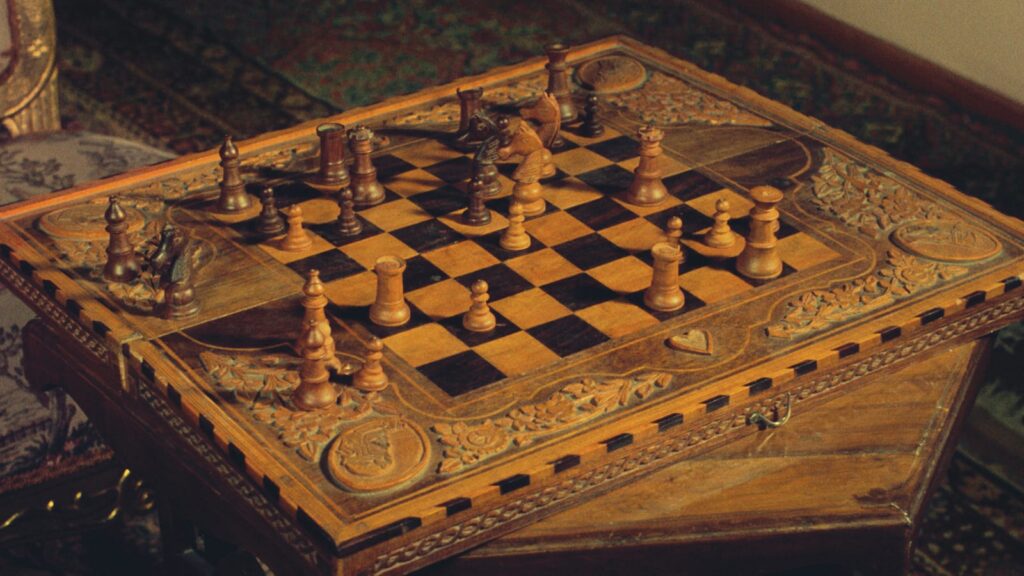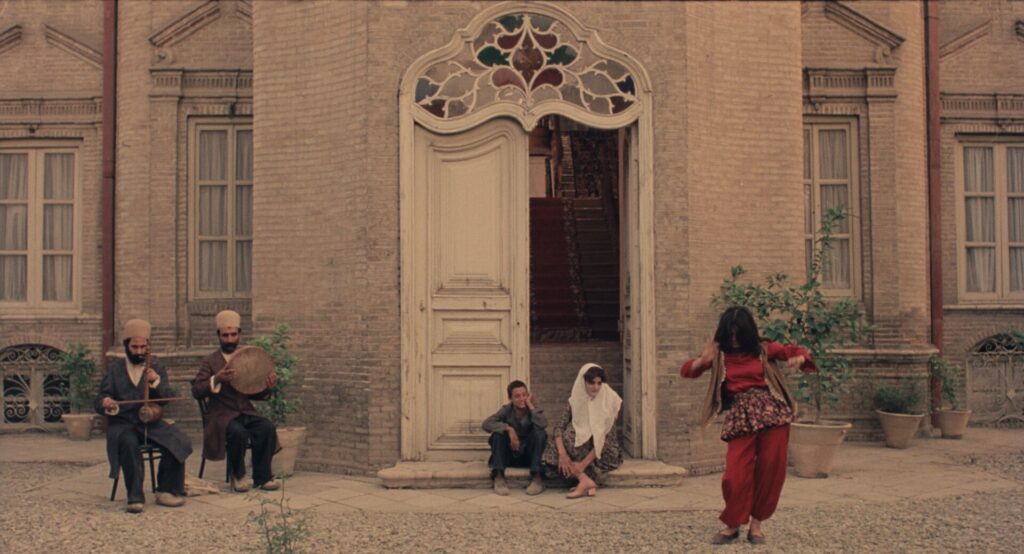At a film festival in 1970s Iran, after the screening of The Chess of the Wind, a critic brutally asked the director Mohammad Reza Aslani, “Who has permitted you to be a director?” Later, another critic wrote “What have the people done wrong that he wants to be a filmmaker?”
The critics posed this question to a director whose film is now recognized as one of the best Iranian movies in history – even within the flourishing context of 1970s Iranian cinema. The experience of watching The Chess of the Wind, especially considering the realistic and poetic context of Iranian cinema and the technological restrictions of the time, is stunning. The painterly cinematography and compositions, the meticulous decoupage and mise-en-scène, the camera movement, all of which become part of the narrative. The implicit references to both Iranian and European art, and the shockingly anachronistic zoom-out after the final scene, all make this film stand out. However, the movie was bashed by both the critics and the audience at the time of its screening and ignored in the histories of Iranian cinema, only to be rediscovered decades later.
The movie’s plot is full of intentional ambiguities and paradoxes, as if it is an expressionist effort to transmit the sense of fear and conspiracy felt by the main character rather than a well-crafted sensible story. In the 1920s, in an aristocratic family from the 19th century, following the death of the family matriarch, the paraplegic daughter, aided by her maid, fights to maintain control over her inheritance amidst greed and betrayal from the other family members, including her stepfather and his nephews. The story revolves around the conspiracies, ploys, and multi-faceted struggles to erase the potential heirs. It is metaphorical, symbolic, and open to interpretation. Some even suggest it foresees later events in the country.
The story, with its paradoxes, ambiguities, and intentionally disrupted and inaudible dialogues, in a way becomes a source of fear and anxiety in itself. Considering Aslani is known more as a documentary filmmaker than a director of fiction, this makes even more sense. He was one of the main figures of a poetic movement in 1970s Iran whose emphasis was on form rather than meaning, sense rather than ideology, and image rather than word.
Almost half a century after its limited screening and a few exclusive showings in the 2000s, the negatives of the film were accidentally found in a second-hand shop by Aslani’s son. By restoring these negatives, Martin Scorsese’s World Cinema Project made it possible for the film to be internationally screened in high quality. Soon after, it gained attention both inside and outside Iran, and a rich volume was published in Iran in 2021 about the movie, shortly after its rediscovery.
Amongst many meticulously implemented ideas of the film, which have been explored by critics, one of the recurring themes is shadow. Several scenes and the dark yet rich palette of the film imply this, including the famous scene of forging deeds at the beginning. Even in her dream, the main character has experienced a world where “there were no shadows.” The characters in the film are shadow-like presences, plotting conspiracies, and neither the main character nor us, the viewers, will ever get through the obscurity of who is doing what. Also, just like shadows, one can see their traces, but cannot see them themselves. The shadows are not only expressed visually, dialogically, or narratively; music and sound also play a crucial role in conveying the eerie traces of the unseen.
Composed by Sheida Gharachehdaghi, the score fits perfectly into the dark, mysterious, and poetic ethos of the film. Gharachehdaghi, one of the few prominent female composers of the time, studied composition in Vienna and returned to Iran in 1969. Before composing music for The Chess of the Wind, she composed music for several short and feature films, including movies directed by the likes of Bahram Beyzaei. After returning, she established the music centre in the Centre for the Intellectual Development of Child and Adolescent in Iran (CIDC), and systematically implemented the Orff method in music education for the first time. She is known as a contemporary composer, with experiences ranging from operatic works (Fairies, 1989) to pieces for piano solo (The Window to the Garden, 1990), and music for children, composed during her years at CIDC.
In her music, there are occasional direct or subtle references to different Iranian music genres. In Fairies, for example, Iranian music is applied as a narrative tool, directly used yet decontextualized and accompanied by an English translation of a famous contemporary Persian poem, an approach repeated in The Chess of the Wind by the blind musicians who play Iranian classical music out of its context, in a grotesque backdrop. In Chahargah, another piece of hers, an Iranian classical mode is reinterpreted with a contemporary touch. The Chess of the Wind, though, offers a different reading of Iranian musical elements.
Of all the sources of inspiration for her composition, Gharachehdaghi chose one of the most unexpected ones. The film starts with the atonal and unmetered sounds of wind instruments on a background of a metric pattern played by percussion. This combination is very similar to what is known as the music of naghāreh-khāneh (‘naghāreh-room’) in Iran. Naghāreh-khānehs were open rooms usually situated on the top of the gates of certain buildings of significance, hosting a group of musicians, playing wind instruments such as sornā and karenā, and the percussive naghāreh. None of these instruments are typically used in Iranian classical music but are mostly used in certain folklore genres. These musical rooms have existed since at least the 16th century, and European travelers have described its music as “chaotic” and “unpleasant.” Musicians in these rooms had to play before dawn and after sunset, in royal ceremonies, in wars, and on special occasions, such as Islamic holidays or the start of the Iranian New Year. There are few active naghāreh-khānehs in Iran in religious buildings, such as the holy shrines in Qom and Mashhad; therefore, the contemporary connotations of this type of music are more religious than before.

In this context, the composer’s choice of this spatio-musical tradition makes more sense. Apart from its historical character, which suits the setting of the story, the amelodic (or even atonal), chaotic, yet polyphonic nature of naghāreh-khāneh’s music fits the multi-layered interplay of conspiracies within the house. Its religious and apocalyptic connotations, reminiscent of the Islamic musical idea of The Trumpet of Israfil, which also heralds the resurrection of the dead, serve the end-of-an-era narrative of the film. Its intertwining with themes of war and terror further emphasizes the violent fate of the characters.
What makes this choice more meaningful is its capacity to be re-framed through an atonal reading, which makes it both contemporary and mysterious. Apart from the opening credits, the composed music score is used in only three other scenes, all of which are murder scenes. In these scenes, the music remains arhythmic and atonal, with occasional vague references to Iranian intervals and melodic figures. Similar to the director’s gothic reading of Iranian architecture, the composer offers an unconventional interpretation of Iranian musical elements, which is not lyrical or nostalgic, but rather grotesque, mysterious, and terrifying.
The sounds used in the movie, as heard in the record, also play an important role in emphasizing the gothic ethos of the movie. The shadows are heard in the sounds and voices with invisible sources, such as the coughs and laughter of a supposedly dead character apparently coming from nowhere. Other musical elements fill the silence in the eeriest way, such as the sounds made by the main character’s wooden wheelchair, or the ticking sound of the clock and the clinks of the metal flail which, in the murder scene, are dissolved into the music.
These elements represent gaps, silences, or absences: the wheelchair’s sound represents the main character’s pain, and the constant ticking and clinking are shadows of their fear of the supposedly murdered man – even after his death. The sounds, just like the visual elements of the film, are the sonic shadows of the characters, who remain inaccessible throughout the entire film. Aslani’s movie and Gharachedaghi’s score mirror the story and its characters: after decades of dwelling in shadows, they rose from the dead and emerged into the light.


